Designing the Business Ecosystem of a Decentralised Energy Datahub
Abstract
:1. Introduction
2. Materials and Models
- Wholesale and retail electricity prices
- Faster, easier, more efficient and more customer-friendly billing
- Consumption metering per 15 min via Automated Meter Reading (AMR)
- Power outage assessment and early warning mechanisms
- Fast detection and locating the anomalies in the power system
- Real-time pricing or other smart tariff services
- Demand Response (DR) measures to save energy
- Efficiency in energy generation
- Algorithmic trading
- Automated trading
2.1. The Business Ecosystem of the DenHub
2.1.1. The Problem You Want to Solve
- A.
- The size of the problem
- B.
- An ecosystem as a right choice
- C.
- The ecosystem you need
2.1.2. Stakeholders and Participants of the Ecosystem
- A.
- What are the players and their roles?
- Transmission System Operators (TSOs)-Full Access (Read and Write)
- Distribution System Operators (DSOs)-Read-Only Access
- Premium Customers-Read-Only Access
- Basic Customers-Profile Access
- Regulators-Read-Only Access
- Electricity Retailers-Read-Only Access
- Research Centers-Read-Only Access
- Entrepreneurs-Read-Only Access
- The Datahub-Full Access (including commit access)
- B.
- Who should be the orchestrator?
- C.
- How can the orchestrator motivate the other players?
2.1.3. The Initial Governance Model of the Ecosystem
- A.
- How open should the ecosystem be?
- B.
- What should the orchestrator control?
2.1.4. Capturing the Value of the Ecosystem
- A.
- What and whom should you charge?
2.1.5. Solving the Chicken-Egg Problem
- A.
- What does it take to achieve critical mass?
- B.
- What is the minimum viable ecosystem?
- C.
- Which side of the market should you focus on?
2.1.6. Ensuring the Evolvability of Your Ecosystem
- A.
- How can you scale/defend the ecosystem?
- B.
- How can you expand the ecosystem?
- C.
- Protecting against backlash
2.2. The Enabling Technology: Smart Metering
2.2.1. Smart Metering
2.2.2. Smart Metering Adaption
2.2.3. Working Principles of Smart Metering
- A.
- The smart metering device
- B.
- The data concentrator
- C.
- A communication system that enables bi-directional data flow
- D.
- Central management and control systems
3. Methods
3.1. Incentives Structure
- –
- Bitcoin and Ethereum Blockchain (Proof of Work): approx. 15 transactions per second.
- –
- Ethereum 2.0 Blockchain (Proof of Stake): approx. 100,000 transactions per second.
3.2. Blockchain Typology
3.2.1. Public Systems
3.2.2. Private Systems
4. Results
4.1. Decentralised Storage and Cloud
4.1.1. Cloud Storage Networks
4.1.2. Decentralised Storage Networks
4.1.3. Blockchain-Based Decentralised Storage Systems
4.2. The DenHub Model and Comparisons
4.3. GDPR and Date Security
4.3.1. Smart Meters
4.3.2. Blockchain
5. Discussion
6. Conclusions and Impact
Author Contributions
Funding
Institutional Review Board Statement
Informed Consent Statement
Data Availability Statement
Conflicts of Interest
References
- Wells, D. Data Hubs—What’s Next in Data Architecture? 2019. Available online: https://www.eckerson.com/articles/data-hubs-what-s-next-in-data-architecture (accessed on 15 July 2021).
- Ernst & Young. Energy Datahub Stakeholder Insights, Brisbane; Ernst & Young: Sydney, Australia, 2018. [Google Scholar]
- Küfeoğlu, S.; Üçler, Ş. Designing the business model of an energy Datahub. Electr. J. 2021, 34, 106907. [Google Scholar] [CrossRef]
- Western Power. Energy Data Hub. 2021. Available online: https://www.westernpower.co.uk/our-network/energy-data-hub (accessed on 15 July 2021).
- Fingrid. What Is Datahub? 2021. Available online: https://www.fingrid.fi/en/electricity-market/datahub (accessed on 15 July 2021).
- International Energy Agency. Empowering Cities for a Net Zero Future: Unlocking Resilient, Smart, Sustainable Urban Energy Systems; IEA: Paris, France, 2021.
- Alahakoon, D.; Yu, X. Smart Electricity Meter Data Intelligence for Future Energy Systems: A Survey. IEEE Trans. Ind. Inform. 2016, 12, 425–436. [Google Scholar] [CrossRef]
- Cabral, J.E.; Pinto, J.O.P.; Martins, E.M.; Pinto, A.M.A.C. Fraud detection in high voltage electricity consumers using data mining. In Proceedings of the 2008 IEEE/PES Transmission and Distribution Conference and Exposition, Chicago, IL, USA, 21–24 April 2008; pp. 1–5. [Google Scholar] [CrossRef]
- Gareta, R.; Romeo, L.M.; Gil, A. Forecasting of electricity prices with neural networks. Energy Convers. Manag. 2006, 47, 1770–1778. [Google Scholar] [CrossRef]
- Company, D.C. DCC Web Page. 2020. Available online: https://www.smartdcc.co.uk/ (accessed on 12 May 2020).
- Lund, H.; Østergaard, P.A.; Connolly, D.; Mathiesen, B.V. Smart energy and smart energy systems. Energy 2017, 137, 556–565. [Google Scholar] [CrossRef]
- O’connell, N.; Pinson, P.; Madsen, H.; O’malley, M. Benefits and challenges of electrical demand response: A critical review. Renew. Sustain. Energy Rev. 2014, 39, 686–699. [Google Scholar] [CrossRef]
- Perera, A.; Nik, V.M.; Wickramasinghe, P.; Scartezzini, J.-L. Redefining energy system flexibility for distributed energy system design. Appl. Energy 2019, 253, 113572. [Google Scholar] [CrossRef]
- European Forum for Energy Business Information. Survey: Datahub. 2019. Available online: https://mwgstorage1.blob.core.windows.net/public/Ebix/EBG%20Survey%20DataHub%20v1r1%2020190607%20(1).pdf (accessed on 8 June 2020).
- Sovacool, B.K.; Del Rio, D.F. Smart home technologies in Europe: A critical review of concepts, benefits, risks and policies. Renew. Sustain. Energy Rev. 2019, 120, 109663. [Google Scholar] [CrossRef]
- ebIX Business Group. Survey: DataHub, s.l.: European Forum for Energy Business Information eXchange. 2019. Available online: https://mwgstorage1.blob.core.windows.net/public/Ebix/EBG%20Survey%20DataHub%20v1r0%2020190328.pdf (accessed on 15 July 2021).
- Pidun, U.; Reeves, M.; Schüssler, M. How Do You “Design” a Business Ecosystem? 2020. Available online: https://www.bcg.com/publications/2020/how-do-you-design-a-business-ecosystem (accessed on 16 August 2021).
- Conejo, A.; Sioshansi, R. Rethinking restructured electricity market design: Lessons learned and future needs. Int. J. Electr. Power Energy Syst. 2018, 98, 520–530. [Google Scholar] [CrossRef]
- De Vries, A. Bitcoin’s growing energy problem. Joule 2018, 2, 801–805. [Google Scholar] [CrossRef] [Green Version]
- Küfeoglu, S.; Liu, G.; Anaya, K.; Pollitt, M. Digitalisation and New Business Models in Energy Sector; Faculty of Economics, University of Cambridge: Cambridge, UK, 2019. [Google Scholar]
- Le, T.N.; Chin, W.L.; Truong, D.K. Advanced Metering Infrastructure Based on Smart Meters in Smart Grid. In Smart Metering Technology and Services-Inspirations for Energy Utilities; Elsevier: Amsterdam, The Netherlands, 2016. [Google Scholar]
- European Commission DG Energy. European Smart Metering Benchmark, Brugge: S.n. 2019. Available online: https://www.vert.lt/SiteAssets/teises-aktai/EU28%20Smart%20Metering%20Benchmark%20Revised%20Final%20Report.pdf (accessed on 15 July 2021).
- Department for Business, Energy & Industrial Strategy (BEIS). Smart Meter Statistics in Great Britain: Quarterly Report to End December 2020, London; Department for Business, Energy & Industrial Strategy: London, UK, 2021.
- Statista. Number of Households in the US 1960–2020; Statista Research Department: New York, NY, USA, 2021. [Google Scholar]
- US Energy Information Administration. How Many Smart Meters Are Installed in the United States, and Who Has Them? 2020. Available online: https://www.eia.gov/tools/faqs/faq.php?id=108&t=3 (accessed on 16 July 2021).
- Simon, F. Smart Meter Woes Hold Back Digitalisation of EU Power Sector. 2019. Available online: https://www.euractiv.com/section/energy/news/smart-meter-woes-hold-back-digitalisation-of-eu-power-sector/ (accessed on 16 July 2021).
- Gerpott, T.J.; Paukert, M. Determinants of willingness to pay for smart meters: An empirical analysis of household customers in Germany. Energy Policy 2013, 61, 483–495. [Google Scholar] [CrossRef]
- Uribe-Pérez, N.; Hernández, L.; De la Vega, D.; Angulo, I. State of the Art and Trends Review of Smart Metering in Electricity Grids. Appl. Sci. 2016, 6, 68–92. [Google Scholar] [CrossRef]
- Lipošćak, Z.; Bošković, M. Survey of Smart Metering Communication Technologies. Eurocon 2013, 2013, 1391–1400. [Google Scholar]
- Androutsellis-Theotokis, S.; Spinellis, D. A survey of peer-to-peer content distribution technologies. ACM Comput. Surv. 2004, 36, 335–371. [Google Scholar] [CrossRef]
- Beck, R.; Stenum, J.; Lollike, N.; Malone, S. Blockchain—The Gateway to Trust-Free Cryptographic Transactions. Istanbul, s.n. 2016. Available online: https://pure.itu.dk/portal/en/publications/blockchain--the-gateway-to-trustfree-cryptographic-transactions(c0965a66-038d-456f-b1c2-bb32282bd28a).html (accessed on 15 July 2021).
- Küfeoğlu, S.; Özkuran, M. Bitcoin mining: A global review of energy and power demand. In Energy Research & Social Science; Elsevier: Amsterdam, The Netherlands, 2019. [Google Scholar]
- Zeng, F.; Hu, Z.; Chen, R.; Yang, Z. Determinants of online service satisfaction and their impacts on behavioural intentions. Total Qual. Manag. 2009, 20, 953–969. [Google Scholar] [CrossRef]
- Mahmood, A.W. Survey of Consensus Protocols. 2020. Available online: https://papers.ssrn.com/sol3/papers.cfm?abstract_id=3556482 (accessed on 16 July 2021).
- David, V.; Champine, L. Sia: Simple Decentralised Storage; Nebulous Inc.: Boston, MA, USA, 2014; Available online: https://sia.tech/sia.pdf (accessed on 15 July 2021).
- Benet, J. IPFS—Content Addressed, Versioned, P2P File System. arXiv 2018, arXiv:1407.3561. [Google Scholar]
- Riemann, R. TechDispatch #2: Smart Meters in Smart Homes. 2019. Available online: https://edps.europa.eu/data-protection/our-work/publications/techdispatch/techdispatch-2-smart-meters-smart-homes_en (accessed on 16 July 2021).
- European Parliament EUR-Lex—32019L0944—EN—EUR-Lex. Available online: https://eur-lex.europa.eu/eli/dir/2019/944/oj (accessed on 16 July 2020).
- Finck, M. Blockchain and the General Data Protection Regulation—Can Distributed Ledgers Be Squared with European Data Protection Law; European Parliamentary Research Service: Brussels, Belgium, 2019; Available online: https://www.europarl.europa.eu/RegData/etudes/STUD/2019/634445/EPRS_STU(2019)634445_EN.pdf (accessed on 15 July 2021).
- World Economic Forum. Global Agenda Council on the Future of Software & Society. Deep Shift Technology Tipping Points and Societal Impact, Survey Report. 2015. Available online: http://www3.weforum.org/docs/WEF_GAC15_Technological_Tipping_Points_report_2015.pdf (accessed on 20 June 2019).
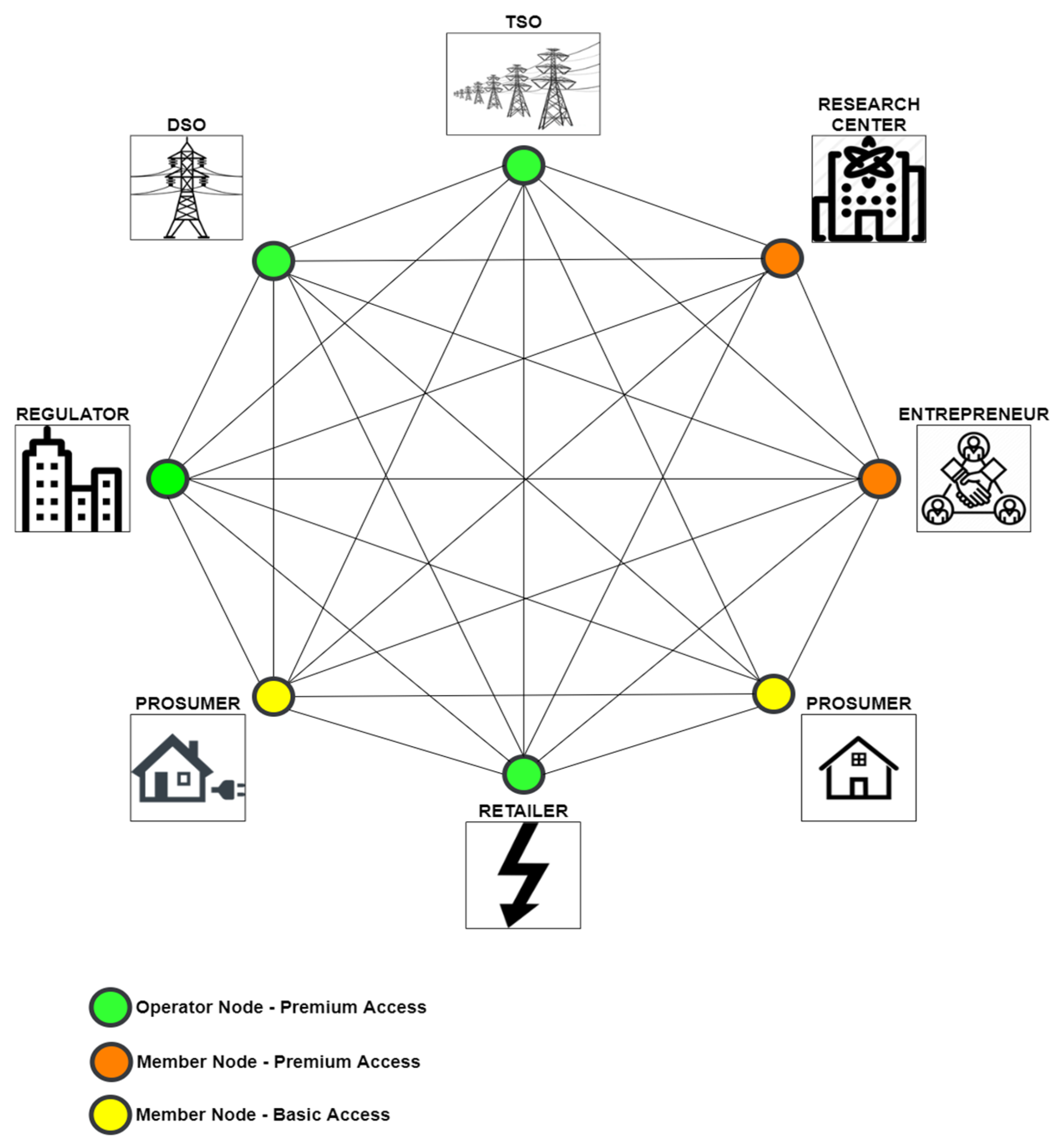
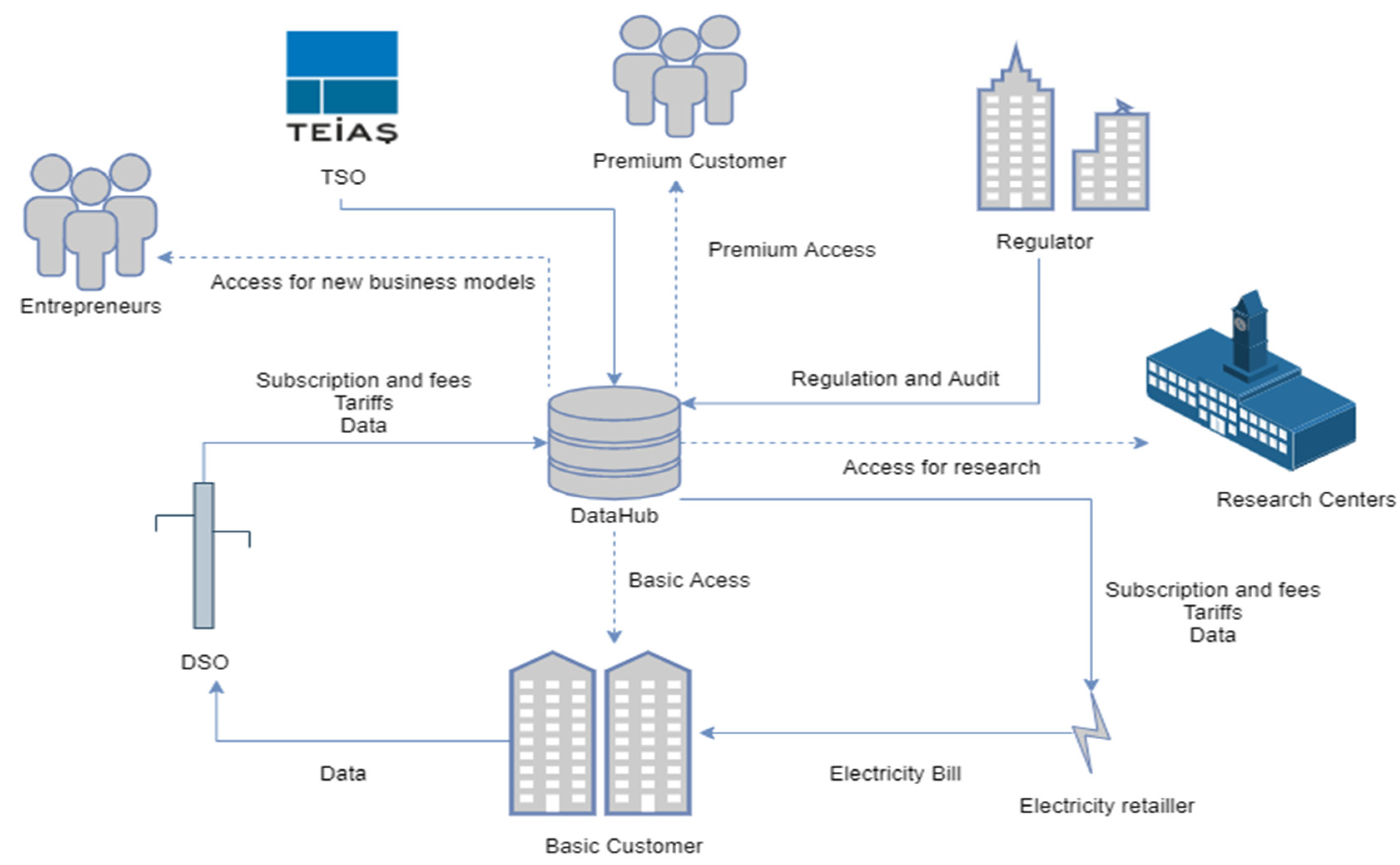
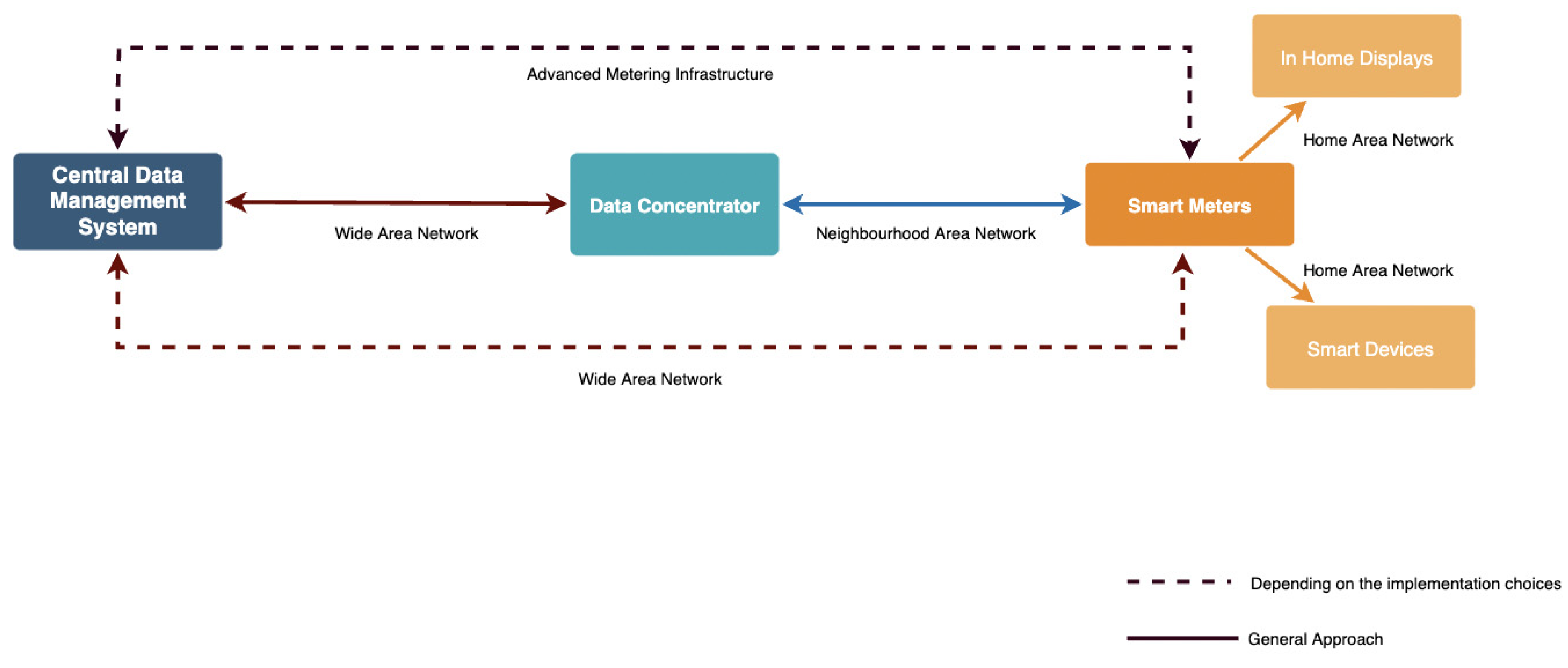
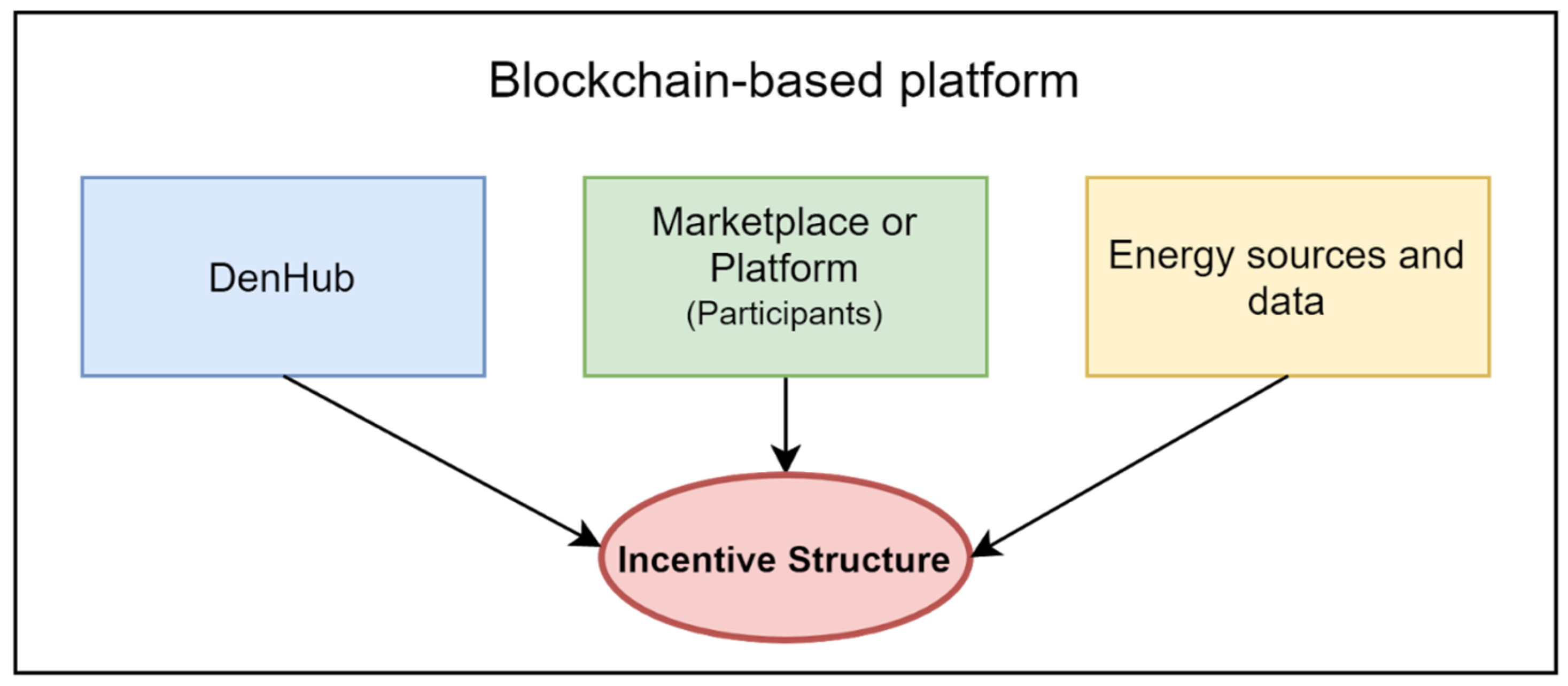
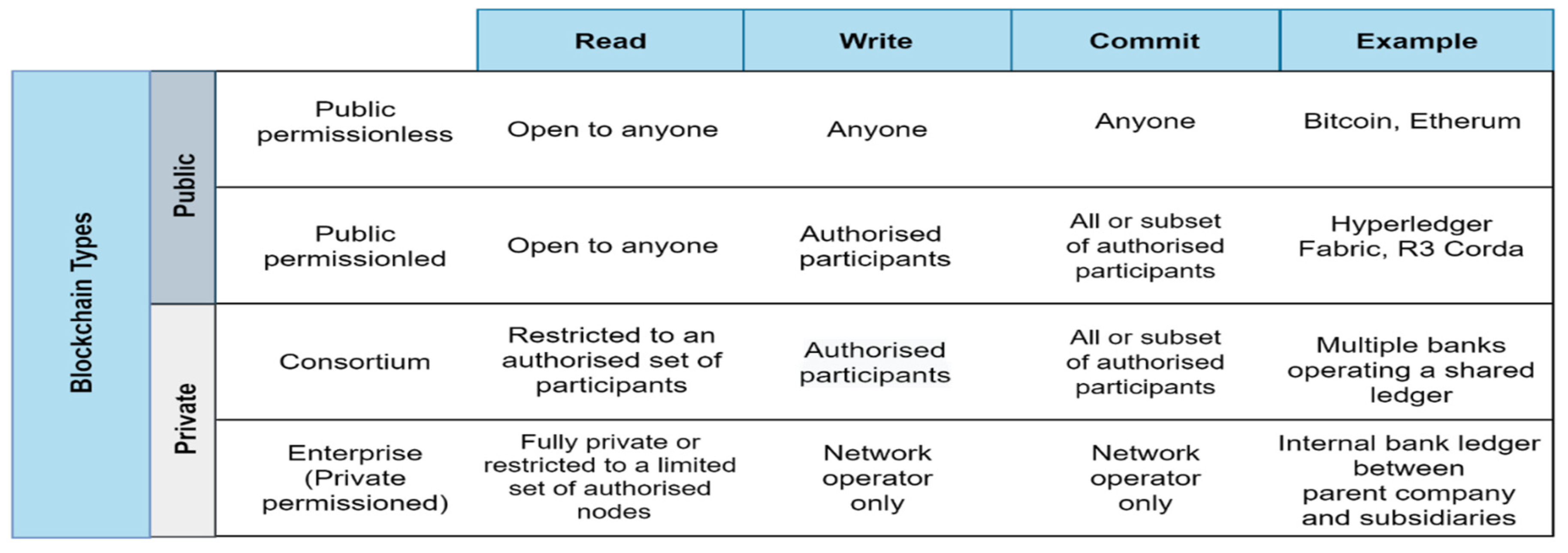
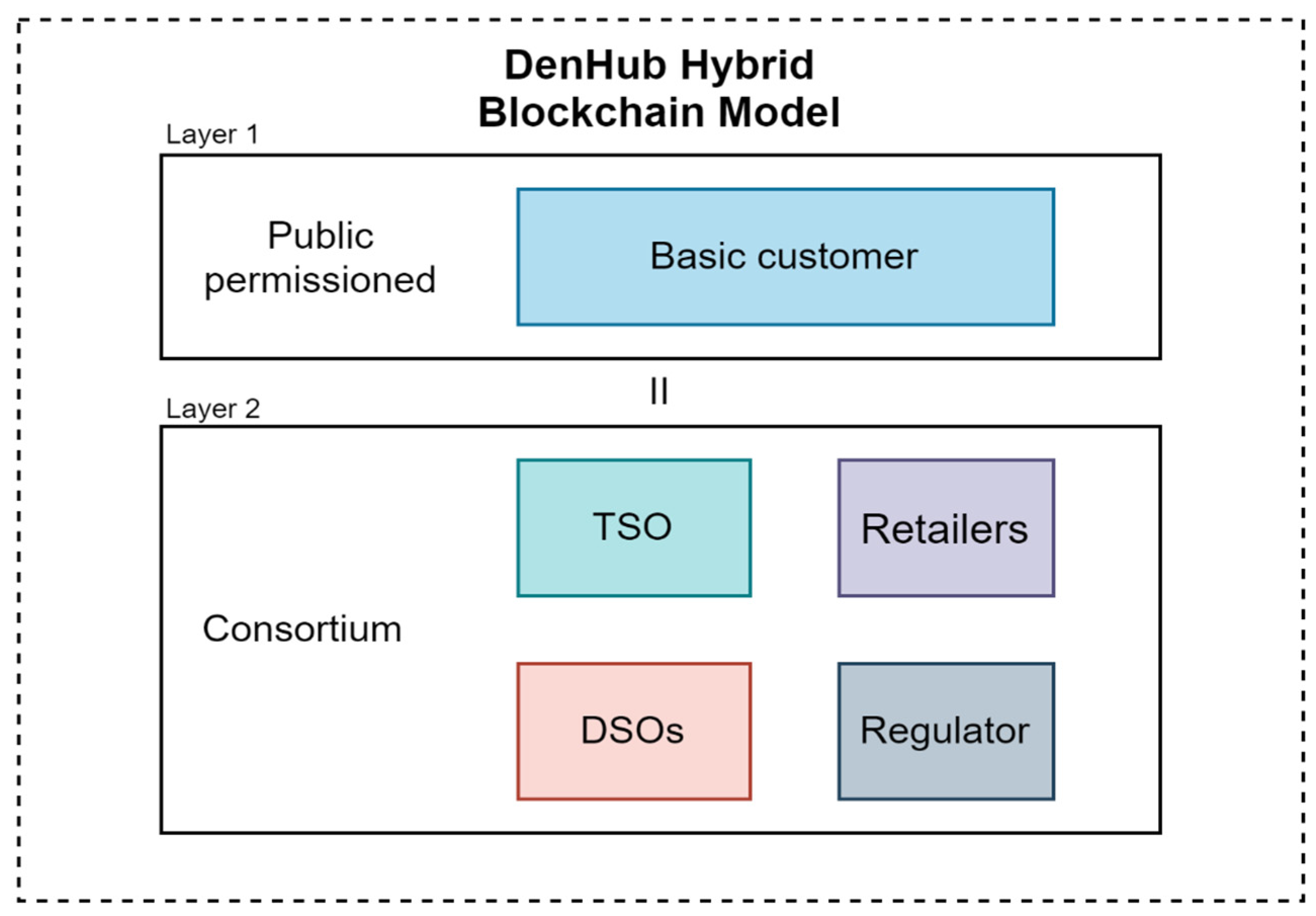
| Company | Country | Datahub Owner | Datahub Usage Situation in State | Finance/Revenue Stream |
|---|---|---|---|---|
| ATRIAS | Belgium | DSO | The construction phase | Not applicable yet |
| ElHub | Norway | Statnett, Norway’s TSO | In service | No information available |
| DCC (Data communication company) | UK | Capita PLC is a private company and regulated by the Office of Gas and Electricity Markets (Ofgem) | In service | Costs are recovered from energy suppliers, network operators, and other authorised users. |
| Energie Data Services Nederland (EDSN) | The Netherlands | DSO and TSO | In service | Depending on the specific function, the Datahub is financed by the grid. |
| Energinet.dk | Denmark | Energinet, Denmark’s TSO | In service | No information available |
| Elmarknadshubb | Sweden | Svenska Kraftnät, Sweden’s TSO | Project on hold due to delays in legislation and other uncertainties | All stakeholders will be billed by the hub owner (TSO). The cost for the Datahub will not be financed by the grid fee. |
| Fingrid Datahub Oy | Finland | Fingrid Oyj, Finland’s TSO | In service | Costs will be charged to users. The exact charging scheme is not available yet. |
| Elering | Estonia | Elering, Estonia’s TSO | In service | No information available |
| Centralised Datahubs | Decentralised Datahubs | |
|---|---|---|
| Ownership/Accountability | The owner of the Datahub is the centralised authority; there is no institution for checking accountability | The owner of the Datahub is the network itself, and it is open for all the market players, including basic customers |
| Management | Easy to communicate and coordinate | Can be managed by a well-constructed consensus of the market players |
| Updates/Changes | Top-down approach | Collective approach |
| Process Maintenance | Easy to maintain | Small changes generally are ignored |
| Security | Hard to protect; records will be held only in centres, and back-ups are held in external centres. | Easy to protect; records will be held for all of the network participants |
| Privacy/Access | Premium customers, including DSOs, TSOs, regulating authorities, exchanges, and retailers with premium access | |
| Basic customers with basic access | ||
| Risk Assessment | Single point of failure | No single point of failure, storing data across all network of computer |
| Scalability | Easy to distribute data to users from a single-centre, high | A bottleneck for current decentralised systems, especially with large numbers of users, but can be handled with several techniques (sharding, block size, DAGs). |
| Regulation | Large number of third parties mean more regulation and complexity | Designed to be more compatible with regulations, few third parties, transparent participant and smart contract structure |
| Bitcoin | Ethereum | |
|---|---|---|
| Release date | January 2009 | June 2015 |
| Usage | To buy goods and services, to store value | To create distributed applications |
| Purpose | Cryptocurrency created to compete against the gold standard and fiat currencies | Token able to facilitate smart contracts (e.g., in an energy exchange) |
| Storage Type | Blockchain | Decentralised | Open Source | Scalability | Privacy | Data Processing |
|---|---|---|---|---|---|---|
| Cloud Storage Networks | No | No | No | High | Low | Yes |
| Decentralised Storage Networks | No | Yes | No | Complicated | High | No |
| Blockchain-based Storage Systems | Yes | Yes | Yes | Complicated | High | No |
| DenHub | Yes | Yes | Yes | Complicated | High | Yes |
Publisher’s Note: MDPI stays neutral with regard to jurisdictional claims in published maps and institutional affiliations. |
© 2022 by the authors. Licensee MDPI, Basel, Switzerland. This article is an open access article distributed under the terms and conditions of the Creative Commons Attribution (CC BY) license (https://creativecommons.org/licenses/by/4.0/).
Share and Cite
Küfeoğlu, S.; Açıkgöz, E.; Taşcı, Y.E.; Arslan, T.Y.; Priesmann, J.; Praktiknjo, A. Designing the Business Ecosystem of a Decentralised Energy Datahub. Energies 2022, 15, 650. https://doi.org/10.3390/en15020650
Küfeoğlu S, Açıkgöz E, Taşcı YE, Arslan TY, Priesmann J, Praktiknjo A. Designing the Business Ecosystem of a Decentralised Energy Datahub. Energies. 2022; 15(2):650. https://doi.org/10.3390/en15020650
Chicago/Turabian StyleKüfeoğlu, Sinan, Eray Açıkgöz, Yunus Emre Taşcı, Taha Yasin Arslan, Jan Priesmann, and Aaron Praktiknjo. 2022. "Designing the Business Ecosystem of a Decentralised Energy Datahub" Energies 15, no. 2: 650. https://doi.org/10.3390/en15020650
APA StyleKüfeoğlu, S., Açıkgöz, E., Taşcı, Y. E., Arslan, T. Y., Priesmann, J., & Praktiknjo, A. (2022). Designing the Business Ecosystem of a Decentralised Energy Datahub. Energies, 15(2), 650. https://doi.org/10.3390/en15020650






